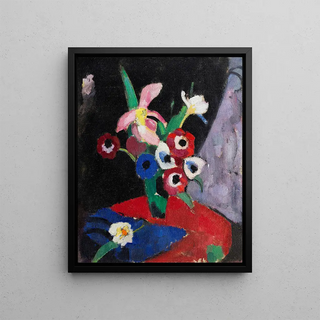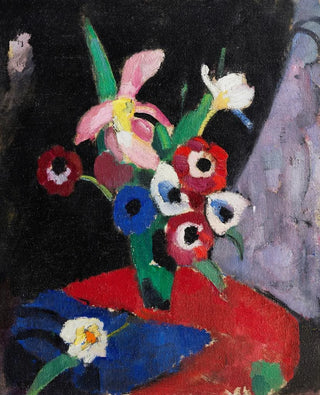Art print | Still life of flowers on black background II - Hermann Stenner


View from behind

Frame (optional)
Nature morte, a quintessential artistic genre, captures the ephemeral essence of floral beauty through a play of light and color. "Reproduction Nature morte de fleurs sur fond noir II" by Hermann Stenner embodies this tradition while adding a touch of modernity. This painting, both delicate and powerful, transports us to a universe where each petal seems to vibrate with its own life. The artist manages to evoke a palpable emotion, a silent contemplation where the beauty of the flowers blends with the depth of the black background. This artwork invites the viewer to introspection, to an intimate dialogue with nature, thus revealing the depth of the human soul in the face of fleeting beauty.
Style and uniqueness of the work
Stenner's style is characterized by a remarkable mastery of color and light. In "Reproduction Nature morte de fleurs sur fond noir II," the vibrant hues of the flowers contrast with the dark background, creating an atmosphere that is both mysterious and enchanting. Each flower is painted with meticulous precision, as if the artist wished to immortalize their fleeting beauty. The shades of pink, purple, and white stand out brilliantly, while the deep black of the background accentuates their radiance. This chromatic choice is not accidental; it evokes emotional depth, a reflection on the fragility of life. Stenner skillfully plays with shadows and lights, transforming a simple bouquet into a true work of art that transcends time.
The artist and his influence
Hermann Stenner, an emblematic figure of the early 20th century, established himself in the art world through his innovative approach to still life. Influenced by the expressionist movement, he combined tradition and modernity, creating works that still resonate today. His artistic journey is marked by an incessant quest for beauty and authenticity. Stenner explored various mediums and techniques, but his passion for floral painting remains one of his distinctive traits. His influence is felt among many contemporary artists, who see in him a forerunner of personal expression.

Matte finish

View from behind

Frame (optional)
Nature morte, a quintessential artistic genre, captures the ephemeral essence of floral beauty through a play of light and color. "Reproduction Nature morte de fleurs sur fond noir II" by Hermann Stenner embodies this tradition while adding a touch of modernity. This painting, both delicate and powerful, transports us to a universe where each petal seems to vibrate with its own life. The artist manages to evoke a palpable emotion, a silent contemplation where the beauty of the flowers blends with the depth of the black background. This artwork invites the viewer to introspection, to an intimate dialogue with nature, thus revealing the depth of the human soul in the face of fleeting beauty.
Style and uniqueness of the work
Stenner's style is characterized by a remarkable mastery of color and light. In "Reproduction Nature morte de fleurs sur fond noir II," the vibrant hues of the flowers contrast with the dark background, creating an atmosphere that is both mysterious and enchanting. Each flower is painted with meticulous precision, as if the artist wished to immortalize their fleeting beauty. The shades of pink, purple, and white stand out brilliantly, while the deep black of the background accentuates their radiance. This chromatic choice is not accidental; it evokes emotional depth, a reflection on the fragility of life. Stenner skillfully plays with shadows and lights, transforming a simple bouquet into a true work of art that transcends time.
The artist and his influence
Hermann Stenner, an emblematic figure of the early 20th century, established himself in the art world through his innovative approach to still life. Influenced by the expressionist movement, he combined tradition and modernity, creating works that still resonate today. His artistic journey is marked by an incessant quest for beauty and authenticity. Stenner explored various mediums and techniques, but his passion for floral painting remains one of his distinctive traits. His influence is felt among many contemporary artists, who see in him a forerunner of personal expression.






